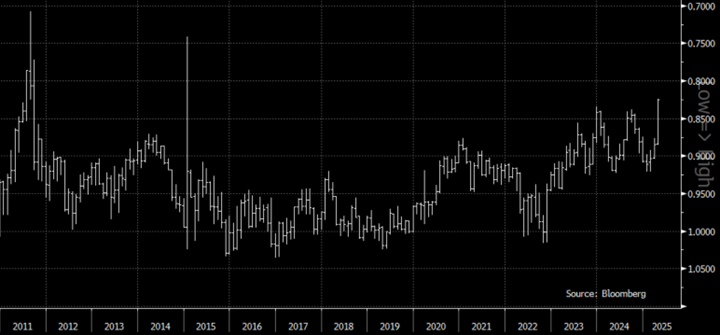Summary
- U.S. dollar weakens around 3.0% mostly due to shifts in U.S. tariff policy.
- Swiss franc appreciates the most (around 6.5%) vs. the U.S. dollar mostly due to its perceived safe-haven status.
- Federal Reserve Bank Governors express concerns associated with risks with current trade policies.
- Bank of Mexico meeting minutes from March 27 indicate greater possibility of a further exchange rate depreciation.
- University of Michigan preliminary consumer sentiment falls to 50.8; estimate 53.8.
U.S. Dollar Tests Fresh Lows Near Euro $ 1.15
Consumer Sentiment Plummets to Second-Lowest Level on Record
This week, the U.S. dollar finished sharply weaker as the market continues to digest the impact of tariffs and softer than expected U.S. inflationary data.
President Donald Trump’s recent announcement of a 90-day pause on certain import tariffs has provided temporary relief to financial markets. However, significant tariffs on key trading partners, including China, Mexico, and Canada, remain in effect, contributing to ongoing economic uncertainty. These tariffs pose risks of increased inflation and slowed growth, with analysts anticipating a resurgence of tariff-driven costs despite a brief decline in consumer prices in March.
Given, the debt market selloff and hence sharply higher interest rates according to conventional economic theory, the U. S. dollar should appreciate. However, the exact opposite has occurred so far with the U.S. dollar depreciating around 3%. This has brought the U.S. Dollar Index to new recent lows.
According to Bloomberg Economist Rana Sajedi, the U.S. dollar’s weakness is related to a ‘structural rebalancing’. One possibility she sites is the market expects a sizeable slowdown in U.S. productivity. Another possibility has to do with the U.S. dollar’s safe-haven status. Under this scenario, global investors sell U.S. denominated assets and buy foreign assets in other currencies.
Swiss Franc Appreciation
The Swiss franc has been a direct beneficiary of the possibility of the U.S. dollar’s eroding status of a safe-haven currency. With an inflation rate of only 0.3% and short-term rates at 0.25%, Switzerland has very low interest rates. Since Monday, U.S. Government 10-year bonds have sold off driving yields higher from below 4.0% to above 4.5%. Whereas the Swiss equivalent 10-year bonds were barely changed with yields sitting around 0.55%. This is one signal the market prefers the stability of Switzerland over the United States presently.
As a result, the Swiss Franc has been rapidly appreciating, Since April 3, the Swiss franc has appreciated versus the U.S. dollar by around 6.5% with most of those gains occurring on Thursday taking the Swiss franc to its highest levels in over 10 years.

Federal Reserve’s Perspective
Federal Reserve officials, such as Kansas City Fed President Jeff Schmid and Dallas Fed President Lorie Logan, have expressed concerns about the persistent risks associated with current trade policies. They emphasize the importance of containing inflation expectations and remain vigilant, monitoring markets closely to maintain financial system stability amid ongoing trade policy disruptions. Most notably Boston Fed President Susan Collins said, “I see monetary policy well positioned to address a wide range of potential economic outcomes in this highly uncertain environment.” Collins also said that her staff estimated an effective tariff rate on imports above 10% would increase inflation a cumulative 0.7% to 1.2% with most of the effect occurring this year.
U.S. Consumer Price Index Report
In March 2025, the U.S. Consumer Price Index (CPI) recorded a 0.1% decline—the first such drop since May 2020—driven by falling oil prices and reduced airfare. The 12-month inflation rate also decelerated to 2.4%, a post-pandemic low, while core CPI, excluding volatile food and energy costs, rose only 0.1%, its smallest increase in nine months. Despite this short-term relief, economists warn that persistent U.S. tariffs could reignite inflationary pressures, potentially complicating the Federal Reserve’s decision-making process.
Bank of Mexico’s Monetary Policy
The Bank of Mexico (Banxico) has been proactive in adjusting its monetary policy in response to both domestic and international economic conditions. On March 27, Banxico unanimously cut its benchmark interest rate by 0.5% to 9.0%, aiming to support the economy amid heightened uncertainty stemming from U.S. tariff policies.
On Thursday, the meeting minutes from the March 27 Banxico were interesting. “Most members noted that risks associated with trade policy changes in the United States would have both upward and downward repercussions for inflation. They pointed out that, on the one hand, there is a greater possibility of a further exchange rate depreciation and, on the other, a greater risk of a further economic weakening.”
Contact Comerica Foreign Exchange
This is not a complete analysis of every material fact regarding any company, industry or security. The information and materials herein have been obtained from sources we consider to be reliable, but Comerica Capital Markets does not warrant, or guarantee, its completeness or accuracy. Materials prepared by Comerica Capital Markets personnel are based on public information. Facts and views presented in this material have not been reviewed by, and may not reflect information known to, professionals in other business areas of Comerica Capital Markets, including investment banking personnel.
The views expressed are those of the author at the time of writing and are subject to change without notice. We do not assume any liability for losses that may result from the reliance by any person upon any such information or opinions. This material has been distributed for general educational/informational purposes only and should not be considered as investment advice or a recommendation for any particular security, strategy or investment product, or as personalized investment advice.

